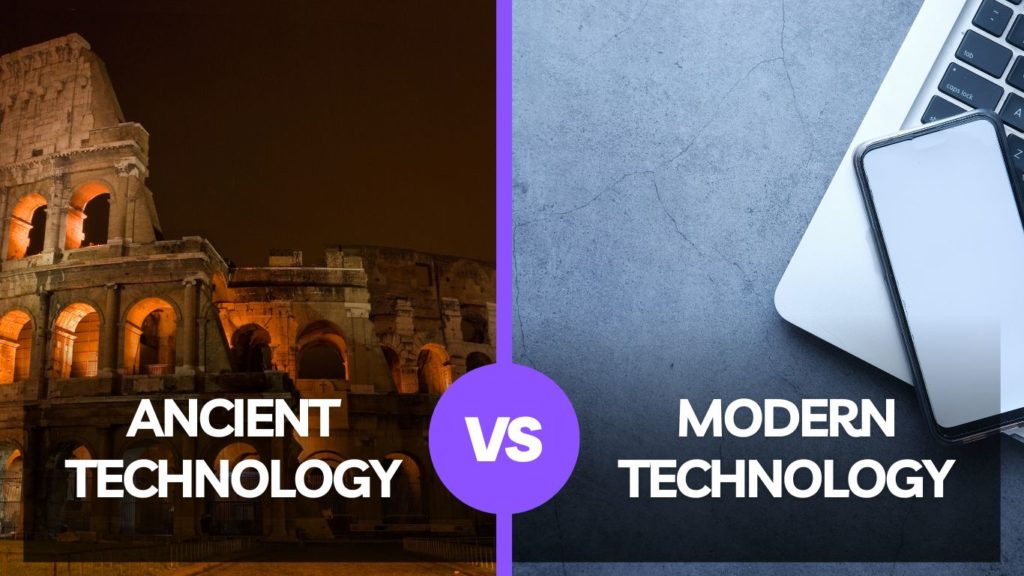
From our days of living as hunters & gatherers, living in caves to escape harsh conditions, and discovering fire, we humans have come a long way in the past thousands of years. Today, humans practically live in every possible place in the world, having built-in cities & towns. Our world has become futuristic as compared to the primitive one of thousands of years ago. As we evolved physically & mentally over the centuries, we advanced our civilization with technology. Today when we think about ‘technology’ we think of our powerful devices, all the rocket science technology of NASA, etc. But way before Elon Musk even decided to make electric cars, the first wheel was invented in 4000 BC.
Ancient vs Modern Technology
The ancient technology of the millennium past has paved the way for today’s amazing technology to flourish. Even though we have come a long way, modern technology is not the only thing responsible for this. This advancement occurred slowly throughout the millennia.
Today we have progressed to the state of thriving in an interconnected, comfortable life. So a major credit of this goes to our ancestors & their “primitive” technology, which served as a foundation for building all the technology of today.
Examining & comparing the technologies of these two time periods will help us understand where the technology of today originates from. Here are some of the simpler machines & technologies that are used as a base in today’s machines.
The Wheel
Long before the cool-looking tires of the Ferrari were made, the first wheel was invented in our world. The primitive wheel was a hard, circular block of wood or stone with a hole in the center. Through which the axle would be inserted. They placed a heavy load on top of this to make it easier to carry cargo over long distances. This mechanism funded the invention of other ancient technologies.
When the wheel is placed horizontally & turned on its vertical axis, it provides the spinning motion for shaping clay materials i.e. potter’s wheel. The wheel & axel after many years were even integrated into the mast of a ship, a more complicated version would be a hydroelectric dam, which uses the force of a waterfall to spin turbines which in turn generates electricity.
The Ramp
Ramps were steep inclines made to aid in transporting heavy construction materials like stones to higher levels. It could be said that the ramp was the first version of the huge cranes we see at construction sites today. Egyptians used a ramp that used to go around the base structure of the pyramids.
Then human laborers pushed the building blocks of stones on the ramp to take the heavy stones to the desired height. This inclined plane was used in many ancient civilizations. Romans even found a use for the ramp in Warcraft. The Romans built a huge ramp to storm the Jewish fort at Masada (today called Israel). Since the fort itself was built on a high cliff, they built a ramp right up to the cliff’s face.
The Wedge
A simple triangular-shaped tool, it looks quite ordinary, but it makes several tasks quite effortless, which would otherwise be taxing. Many simple uses of this ancient technology include separating two objects, lifting an item, etc. It works by converting an applied force (on the blunt end) into a force perpendicular to its surface.
The smaller the wedge is, the less power/force is needed to do the job. Simply stated, it converts the force applied to the sharp end. The most simple example of a wedge, that is even used today, would be an ax. The Egyptians used bronze axes for breaking big stones, the Vikings used them as a weapon of war. Ax was & still is used for chopping wood.
A version of a wedge used by us every day is the forks we use to eat. Although slightly different in shape, it is still the same simple tool. So, it cannot be considered as an obsolete technology yet.
The Lever
It consists of a wooden beam or a rod, pivoted by a fulcrum. The force applied on one end of the lever converts that force to the other end in the opposite direction of the original force. A strong enough lever can lift 100 times the weight of the force applied. A more modern version of the lever is the balance scale, crowbar, scissors, bottle openers, etc.
The Ancient yet Modern City
This city was “The Indus Valley civilization” situated in northwestern India around 2000BC. It was surprisingly advanced for its time. It had modern world solutions like sewage/waste segregation & city planning. There were closed gutters, waste collection, separate public baths, plumbing, etc.
These features reflect the quality of values the residents must have held, like personal cleanliness, clean water for bathing and other purposes & collection of sewage to maintain cleanliness, the city planning represents how they wanted to live in orderly spaces & maintain neatness. All this wasn’t made of present-day raw materials like cement or metal, rather it was all made of stone & wood.
Ancient Medicine
Ancient medicine was mostly founded by a large amount of trial & error. The supernatural theory was quite famous during that era, so to treat diseases the most common method was to conduct rituals to remove the evil spirit from the body.
As time passed, Hippocrates was born, he thought that the cause of the disease could be inside our bodies & not something frivolous as “spirit”. His thesis on “Humorism” is still famous, his theory says that the type of body fluids “humor” you have, and the kind of diseases that are prone to that humor can affect you.
Later, Ayurveda was written, and it is still one of the major practices in medicine. Since it was written in Sanskrit, there is still some deep meaning being discovered today in those sacred texts. Even today, there are a few diseases/medical conditions that just can’t be cured completely by modern medicine.
Comparing Ancient technology to Modern Tech

Ancient technology has its own merit and helped lay the groundwork for modern technological marvels. Below, is a table comparing the two:
| Feature | Ancient Technology | Modern Technology |
|---|---|---|
| Time period | Before the Industrial Revolution | Mostly the 20th and 21st century and ongoing |
| Energy source | Manual labor and heat | Fossil Fuel, Green energy, Electricity |
| Transportation | Manual, animal driven | Motor powered |
| Communication | Handwritten letters | Digital communication |
| Healthcare | No unified science, mostly reliant on herbal remedies | Proper medical structure, backed by scientific theories and practices |
| Production | Manual labor | Use of machines |
| Construction | Basic materials | Advanced construction, 3D printing, etc |
| Agriculture | Unsystematic | Proper industrialization |
| Education | Not emphasized | Formalized and widely available |
Ancient technologies that were ahead of their time
Ancient technology might not seem all that interesting, especially if we are looking at it through our modern lenses, but we have to remember that the foundation of our current technological advancement can be easily found in history. Throughout the ages, there have been philosophers, inventors, scientists, and generally humans who have looked beyond the horizon and done things no one thought possible.
The following are a few examples of ancient technology that was deemed ahead of its time. There is also a video that talks about the past, present, and future of technology for interested readers.
1. The Antikythera Mechanism
It can be considered an ancient computer, originating in Ancient Greece. The Antikythera mechanism was primarily used to predict astrological movements and to determine time and date, especially for the Olympic Games. The first such mechanism was discovered in the wreckage of a trading ship in 1901, and when dated, it was found to belong to 100 BCE.
2. The Great Pyramids of Egypt
Then, there is one of the seven wonders of the world, a prime example of an architectural marvel that has still left modern scientists, architects, and archeologists wondering how it was made. The Great Pyramids of Giza are a set of three huge pyramids located on a large plain, constructed some 4500 years ago, using huge blocks of stone. People have yet to find the exact method by which these were constructed at a time when no machines were available.
The sheer scope of construction has bewildered even the most astute minds, as they wonder how a civilization that only had access to some rudimentary tools was able to transport such stones, carve them, and lift them so high to create these architectural wonders.
3. The Baghdad Battery
The Baghdad battery is a set of three distinct objects, a copper tube, an iron rod, and a ceramic pot. Together, they are believed to function as an electroplating device, or a battery, as they have come to be known over the years. First discovered near Ctesiphon, Iraq, the Baghdad battery was determined to be from either the Sassanian or the Parthian empire, dating back anywhere between 150 BCE and 650 AD.
4. Damascus steel
Damascus steel was famous for its application in sword-making. The steel was durable and much stronger and sharper than any other at that time. It is believed to have originated in the 9th century. Throughout history, the demand for Damascus steel has been at an all-time high, only waning due to the introduction of firearms.
Conclusion
To conclude, ancient technologies have certainly been the foundation on which today’s technology has been built. Some of the simple tools & mechanisms of a bygone era are still being used in much of our complicated machinery. Despite the way ancient technology looked, it certainly served its purpose for our ancestors. There are many cases that have been reported by scientists that such technology in those times shouldn’t have been possible. It just might be a little too soon to declare a winner.